Therapeutic Alliance: Skills and Components Explained
VerifiedAdded on 2022/08/26
|6
|1410
|19
Presentation
AI Summary
This presentation provides a comprehensive overview of therapeutic alliance, a crucial element in healthcare, defining it as the connection between a healthcare consumer and a therapist. It emphasizes the importance of effective communication, both verbal and non-verbal, including greeting patients appropriately, explaining procedures, and using respectful language. The presentation outlines communication skills like attending, active listening, and asking questions with cultural competence and empathy. It also explores motivational interviewing, highlighting components like expressing empathy and building rapport. Finally, it discusses how these skills can be incorporated into clinical practice through therapist training and organizational policies promoting cultural competence and preventing discrimination. The presentation draws on several research papers to support its claims.

Running head: THERAPUTIC ALLIENCE
THERAPUTIC ALLIANCE
Name of the Student
Name of the University
Author Note
THERAPUTIC ALLIANCE
Name of the Student
Name of the University
Author Note
Paraphrase This Document
Need a fresh take? Get an instant paraphrase of this document with our AI Paraphraser
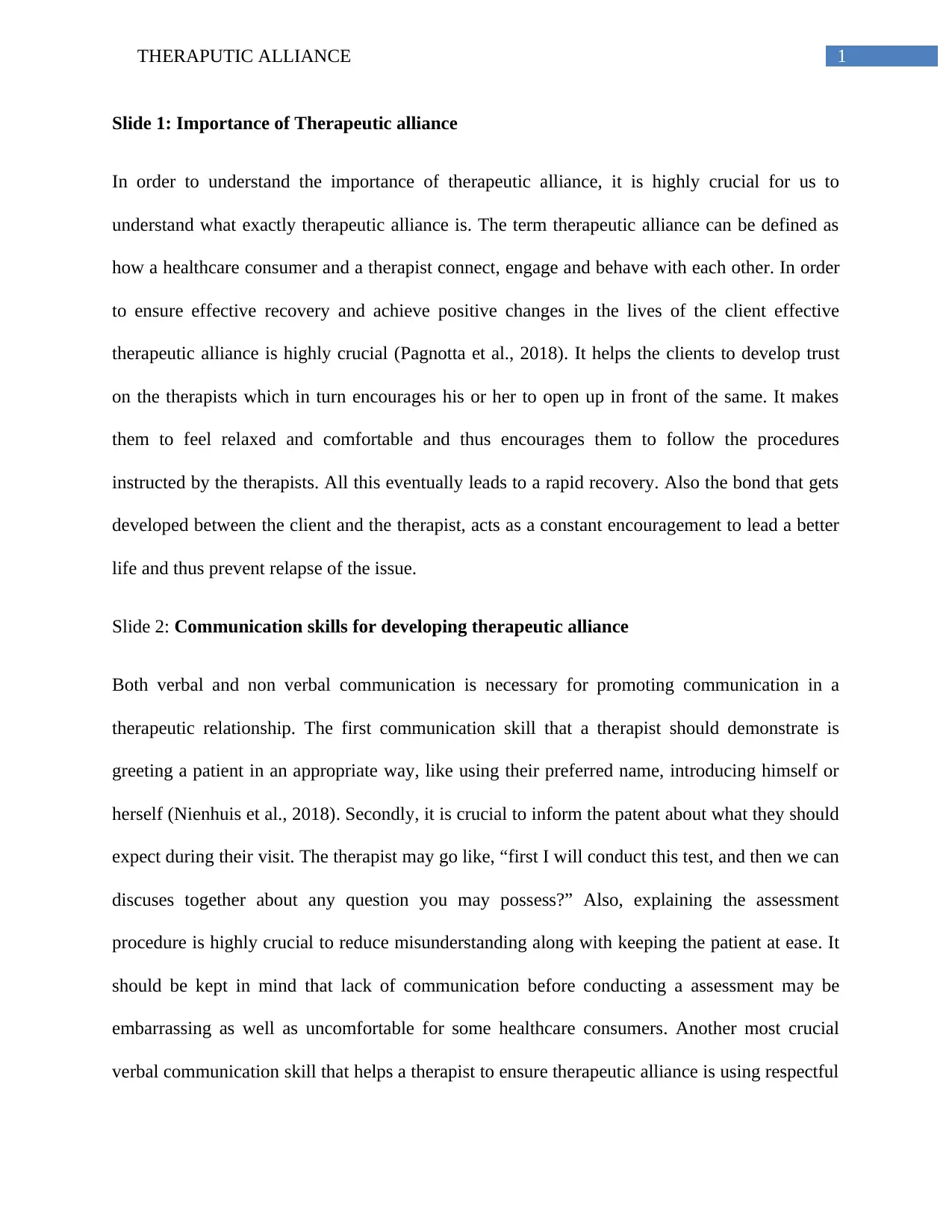
1THERAPUTIC ALLIANCE
Slide 1: Importance of Therapeutic alliance
In order to understand the importance of therapeutic alliance, it is highly crucial for us to
understand what exactly therapeutic alliance is. The term therapeutic alliance can be defined as
how a healthcare consumer and a therapist connect, engage and behave with each other. In order
to ensure effective recovery and achieve positive changes in the lives of the client effective
therapeutic alliance is highly crucial (Pagnotta et al., 2018). It helps the clients to develop trust
on the therapists which in turn encourages his or her to open up in front of the same. It makes
them to feel relaxed and comfortable and thus encourages them to follow the procedures
instructed by the therapists. All this eventually leads to a rapid recovery. Also the bond that gets
developed between the client and the therapist, acts as a constant encouragement to lead a better
life and thus prevent relapse of the issue.
Slide 2: Communication skills for developing therapeutic alliance
Both verbal and non verbal communication is necessary for promoting communication in a
therapeutic relationship. The first communication skill that a therapist should demonstrate is
greeting a patient in an appropriate way, like using their preferred name, introducing himself or
herself (Nienhuis et al., 2018). Secondly, it is crucial to inform the patent about what they should
expect during their visit. The therapist may go like, “first I will conduct this test, and then we can
discuses together about any question you may possess?” Also, explaining the assessment
procedure is highly crucial to reduce misunderstanding along with keeping the patient at ease. It
should be kept in mind that lack of communication before conducting a assessment may be
embarrassing as well as uncomfortable for some healthcare consumers. Another most crucial
verbal communication skill that helps a therapist to ensure therapeutic alliance is using respectful
Slide 1: Importance of Therapeutic alliance
In order to understand the importance of therapeutic alliance, it is highly crucial for us to
understand what exactly therapeutic alliance is. The term therapeutic alliance can be defined as
how a healthcare consumer and a therapist connect, engage and behave with each other. In order
to ensure effective recovery and achieve positive changes in the lives of the client effective
therapeutic alliance is highly crucial (Pagnotta et al., 2018). It helps the clients to develop trust
on the therapists which in turn encourages his or her to open up in front of the same. It makes
them to feel relaxed and comfortable and thus encourages them to follow the procedures
instructed by the therapists. All this eventually leads to a rapid recovery. Also the bond that gets
developed between the client and the therapist, acts as a constant encouragement to lead a better
life and thus prevent relapse of the issue.
Slide 2: Communication skills for developing therapeutic alliance
Both verbal and non verbal communication is necessary for promoting communication in a
therapeutic relationship. The first communication skill that a therapist should demonstrate is
greeting a patient in an appropriate way, like using their preferred name, introducing himself or
herself (Nienhuis et al., 2018). Secondly, it is crucial to inform the patent about what they should
expect during their visit. The therapist may go like, “first I will conduct this test, and then we can
discuses together about any question you may possess?” Also, explaining the assessment
procedure is highly crucial to reduce misunderstanding along with keeping the patient at ease. It
should be kept in mind that lack of communication before conducting a assessment may be
embarrassing as well as uncomfortable for some healthcare consumers. Another most crucial
verbal communication skill that helps a therapist to ensure therapeutic alliance is using respectful
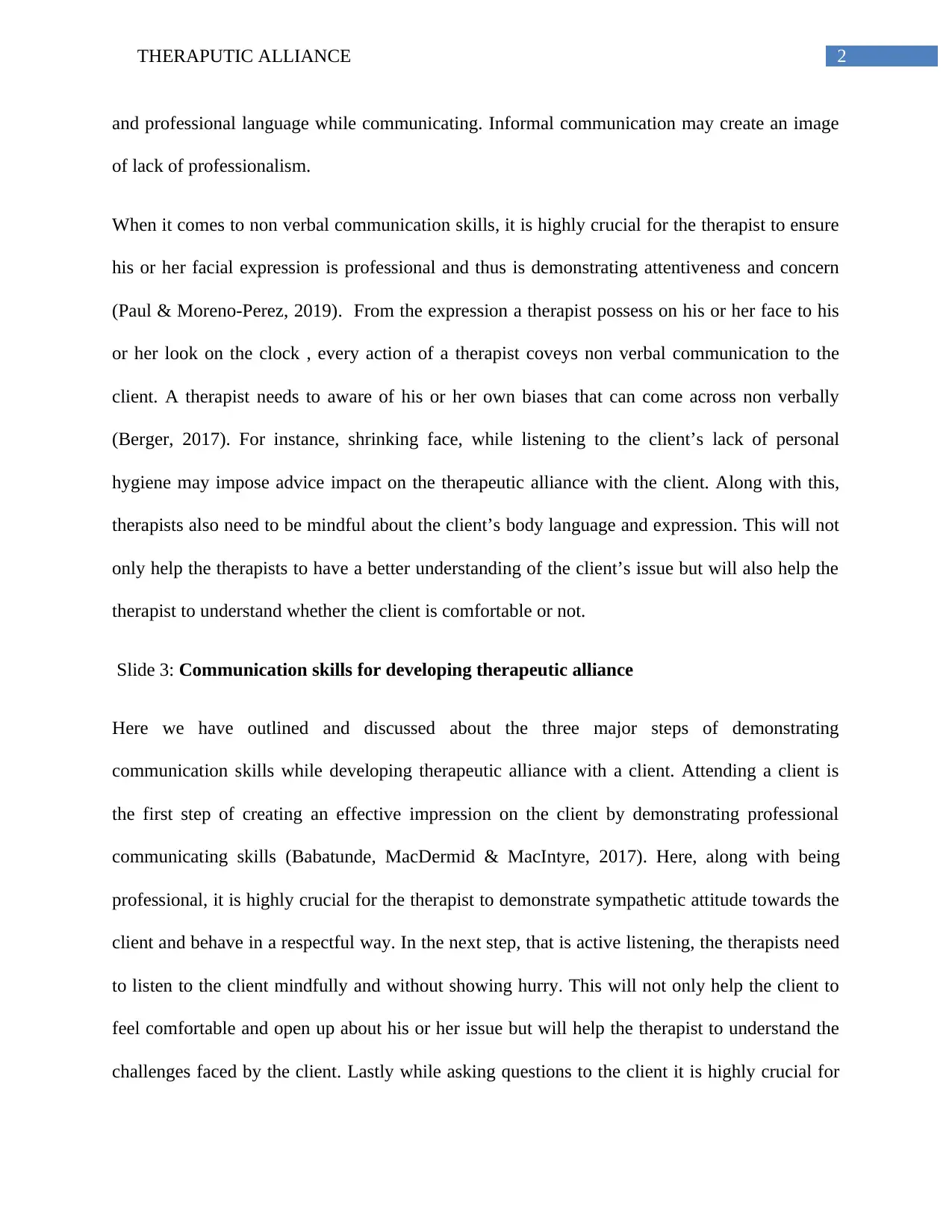
2THERAPUTIC ALLIANCE
and professional language while communicating. Informal communication may create an image
of lack of professionalism.
When it comes to non verbal communication skills, it is highly crucial for the therapist to ensure
his or her facial expression is professional and thus is demonstrating attentiveness and concern
(Paul & Moreno-Perez, 2019). From the expression a therapist possess on his or her face to his
or her look on the clock , every action of a therapist coveys non verbal communication to the
client. A therapist needs to aware of his or her own biases that can come across non verbally
(Berger, 2017). For instance, shrinking face, while listening to the client’s lack of personal
hygiene may impose advice impact on the therapeutic alliance with the client. Along with this,
therapists also need to be mindful about the client’s body language and expression. This will not
only help the therapists to have a better understanding of the client’s issue but will also help the
therapist to understand whether the client is comfortable or not.
Slide 3: Communication skills for developing therapeutic alliance
Here we have outlined and discussed about the three major steps of demonstrating
communication skills while developing therapeutic alliance with a client. Attending a client is
the first step of creating an effective impression on the client by demonstrating professional
communicating skills (Babatunde, MacDermid & MacIntyre, 2017). Here, along with being
professional, it is highly crucial for the therapist to demonstrate sympathetic attitude towards the
client and behave in a respectful way. In the next step, that is active listening, the therapists need
to listen to the client mindfully and without showing hurry. This will not only help the client to
feel comfortable and open up about his or her issue but will help the therapist to understand the
challenges faced by the client. Lastly while asking questions to the client it is highly crucial for
and professional language while communicating. Informal communication may create an image
of lack of professionalism.
When it comes to non verbal communication skills, it is highly crucial for the therapist to ensure
his or her facial expression is professional and thus is demonstrating attentiveness and concern
(Paul & Moreno-Perez, 2019). From the expression a therapist possess on his or her face to his
or her look on the clock , every action of a therapist coveys non verbal communication to the
client. A therapist needs to aware of his or her own biases that can come across non verbally
(Berger, 2017). For instance, shrinking face, while listening to the client’s lack of personal
hygiene may impose advice impact on the therapeutic alliance with the client. Along with this,
therapists also need to be mindful about the client’s body language and expression. This will not
only help the therapists to have a better understanding of the client’s issue but will also help the
therapist to understand whether the client is comfortable or not.
Slide 3: Communication skills for developing therapeutic alliance
Here we have outlined and discussed about the three major steps of demonstrating
communication skills while developing therapeutic alliance with a client. Attending a client is
the first step of creating an effective impression on the client by demonstrating professional
communicating skills (Babatunde, MacDermid & MacIntyre, 2017). Here, along with being
professional, it is highly crucial for the therapist to demonstrate sympathetic attitude towards the
client and behave in a respectful way. In the next step, that is active listening, the therapists need
to listen to the client mindfully and without showing hurry. This will not only help the client to
feel comfortable and open up about his or her issue but will help the therapist to understand the
challenges faced by the client. Lastly while asking questions to the client it is highly crucial for
⊘ This is a preview!⊘
Do you want full access?
Subscribe today to unlock all pages.

Trusted by 1+ million students worldwide
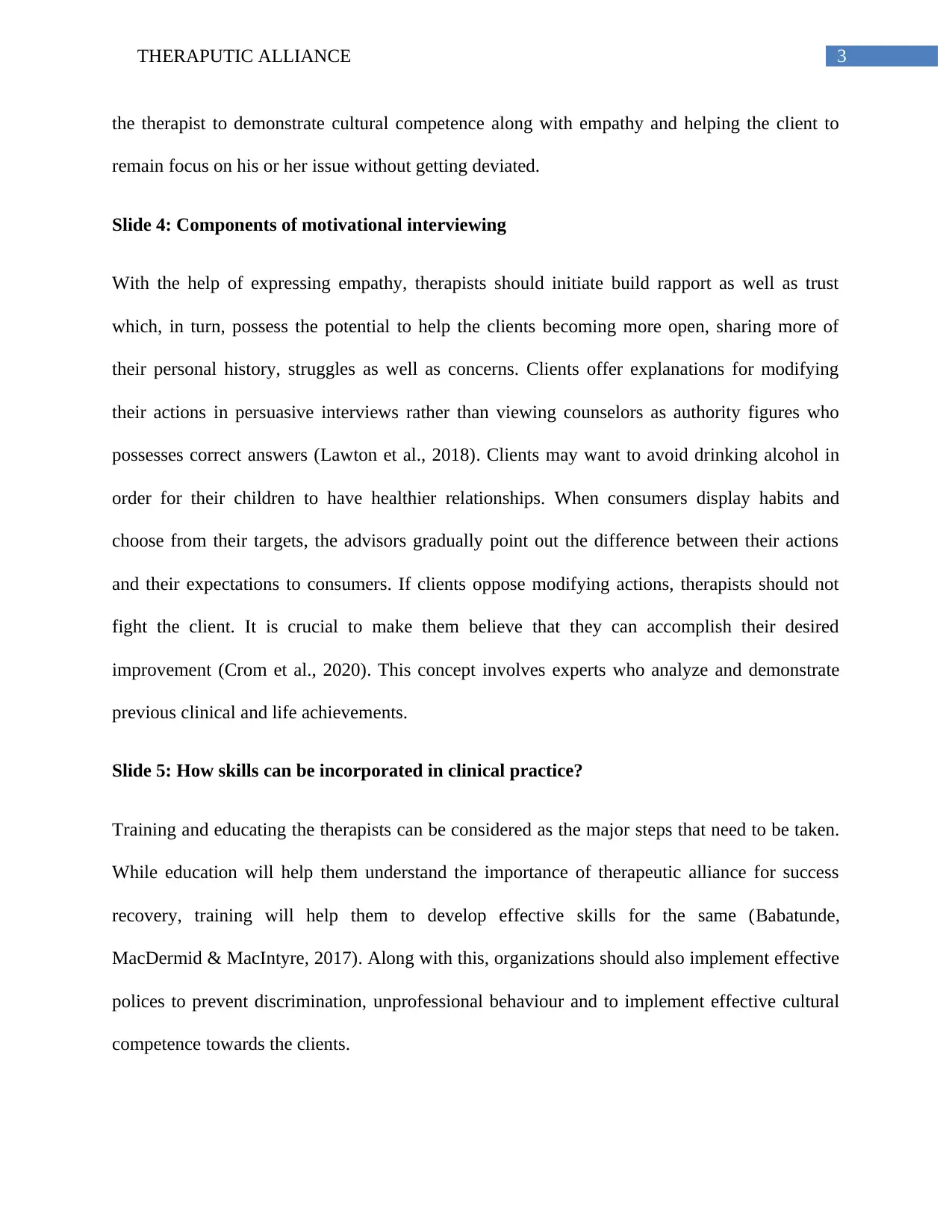
3THERAPUTIC ALLIANCE
the therapist to demonstrate cultural competence along with empathy and helping the client to
remain focus on his or her issue without getting deviated.
Slide 4: Components of motivational interviewing
With the help of expressing empathy, therapists should initiate build rapport as well as trust
which, in turn, possess the potential to help the clients becoming more open, sharing more of
their personal history, struggles as well as concerns. Clients offer explanations for modifying
their actions in persuasive interviews rather than viewing counselors as authority figures who
possesses correct answers (Lawton et al., 2018). Clients may want to avoid drinking alcohol in
order for their children to have healthier relationships. When consumers display habits and
choose from their targets, the advisors gradually point out the difference between their actions
and their expectations to consumers. If clients oppose modifying actions, therapists should not
fight the client. It is crucial to make them believe that they can accomplish their desired
improvement (Crom et al., 2020). This concept involves experts who analyze and demonstrate
previous clinical and life achievements.
Slide 5: How skills can be incorporated in clinical practice?
Training and educating the therapists can be considered as the major steps that need to be taken.
While education will help them understand the importance of therapeutic alliance for success
recovery, training will help them to develop effective skills for the same (Babatunde,
MacDermid & MacIntyre, 2017). Along with this, organizations should also implement effective
polices to prevent discrimination, unprofessional behaviour and to implement effective cultural
competence towards the clients.
the therapist to demonstrate cultural competence along with empathy and helping the client to
remain focus on his or her issue without getting deviated.
Slide 4: Components of motivational interviewing
With the help of expressing empathy, therapists should initiate build rapport as well as trust
which, in turn, possess the potential to help the clients becoming more open, sharing more of
their personal history, struggles as well as concerns. Clients offer explanations for modifying
their actions in persuasive interviews rather than viewing counselors as authority figures who
possesses correct answers (Lawton et al., 2018). Clients may want to avoid drinking alcohol in
order for their children to have healthier relationships. When consumers display habits and
choose from their targets, the advisors gradually point out the difference between their actions
and their expectations to consumers. If clients oppose modifying actions, therapists should not
fight the client. It is crucial to make them believe that they can accomplish their desired
improvement (Crom et al., 2020). This concept involves experts who analyze and demonstrate
previous clinical and life achievements.
Slide 5: How skills can be incorporated in clinical practice?
Training and educating the therapists can be considered as the major steps that need to be taken.
While education will help them understand the importance of therapeutic alliance for success
recovery, training will help them to develop effective skills for the same (Babatunde,
MacDermid & MacIntyre, 2017). Along with this, organizations should also implement effective
polices to prevent discrimination, unprofessional behaviour and to implement effective cultural
competence towards the clients.
Paraphrase This Document
Need a fresh take? Get an instant paraphrase of this document with our AI Paraphraser
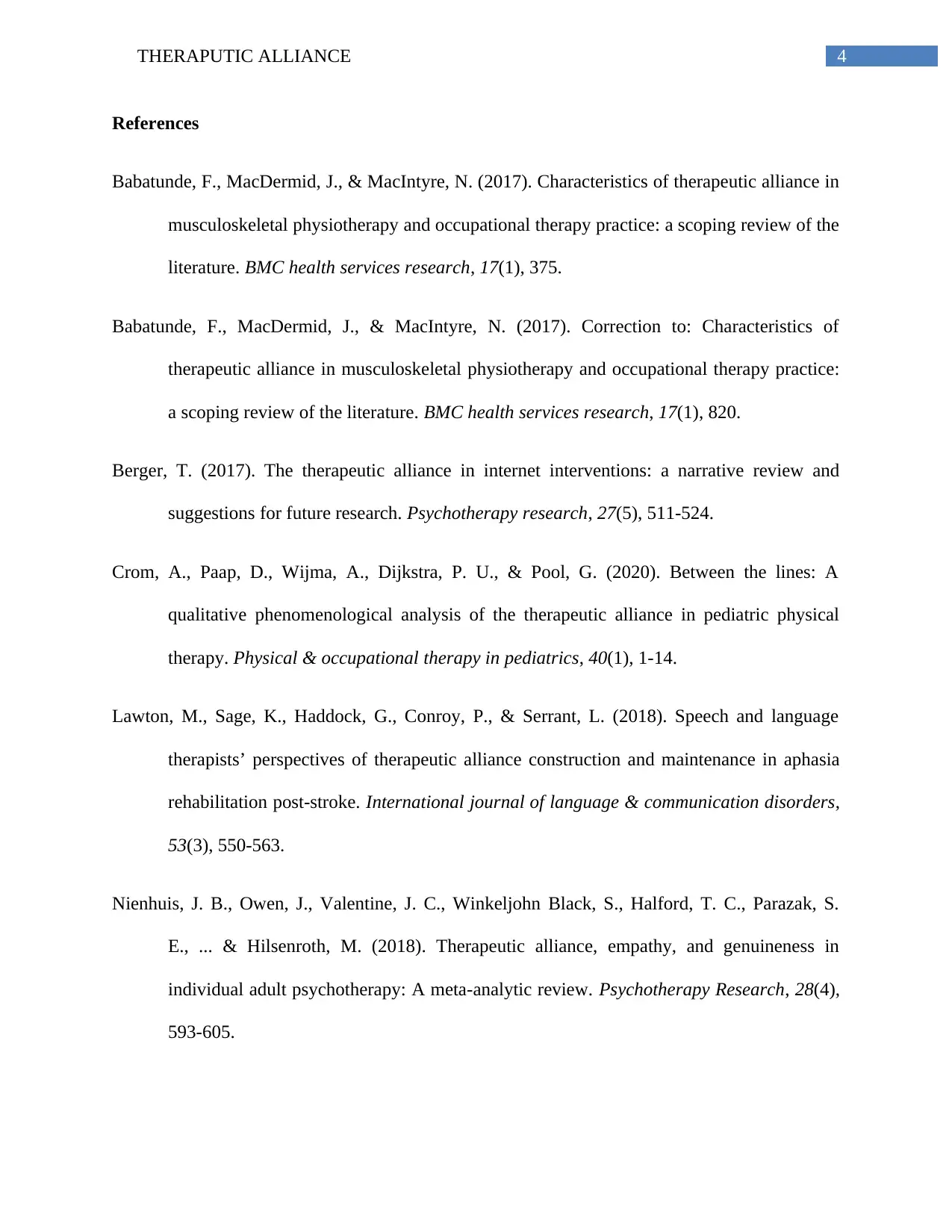
4THERAPUTIC ALLIANCE
References
Babatunde, F., MacDermid, J., & MacIntyre, N. (2017). Characteristics of therapeutic alliance in
musculoskeletal physiotherapy and occupational therapy practice: a scoping review of the
literature. BMC health services research, 17(1), 375.
Babatunde, F., MacDermid, J., & MacIntyre, N. (2017). Correction to: Characteristics of
therapeutic alliance in musculoskeletal physiotherapy and occupational therapy practice:
a scoping review of the literature. BMC health services research, 17(1), 820.
Berger, T. (2017). The therapeutic alliance in internet interventions: a narrative review and
suggestions for future research. Psychotherapy research, 27(5), 511-524.
Crom, A., Paap, D., Wijma, A., Dijkstra, P. U., & Pool, G. (2020). Between the lines: A
qualitative phenomenological analysis of the therapeutic alliance in pediatric physical
therapy. Physical & occupational therapy in pediatrics, 40(1), 1-14.
Lawton, M., Sage, K., Haddock, G., Conroy, P., & Serrant, L. (2018). Speech and language
therapists’ perspectives of therapeutic alliance construction and maintenance in aphasia
rehabilitation post‐stroke. International journal of language & communication disorders,
53(3), 550-563.
Nienhuis, J. B., Owen, J., Valentine, J. C., Winkeljohn Black, S., Halford, T. C., Parazak, S.
E., ... & Hilsenroth, M. (2018). Therapeutic alliance, empathy, and genuineness in
individual adult psychotherapy: A meta-analytic review. Psychotherapy Research, 28(4),
593-605.
References
Babatunde, F., MacDermid, J., & MacIntyre, N. (2017). Characteristics of therapeutic alliance in
musculoskeletal physiotherapy and occupational therapy practice: a scoping review of the
literature. BMC health services research, 17(1), 375.
Babatunde, F., MacDermid, J., & MacIntyre, N. (2017). Correction to: Characteristics of
therapeutic alliance in musculoskeletal physiotherapy and occupational therapy practice:
a scoping review of the literature. BMC health services research, 17(1), 820.
Berger, T. (2017). The therapeutic alliance in internet interventions: a narrative review and
suggestions for future research. Psychotherapy research, 27(5), 511-524.
Crom, A., Paap, D., Wijma, A., Dijkstra, P. U., & Pool, G. (2020). Between the lines: A
qualitative phenomenological analysis of the therapeutic alliance in pediatric physical
therapy. Physical & occupational therapy in pediatrics, 40(1), 1-14.
Lawton, M., Sage, K., Haddock, G., Conroy, P., & Serrant, L. (2018). Speech and language
therapists’ perspectives of therapeutic alliance construction and maintenance in aphasia
rehabilitation post‐stroke. International journal of language & communication disorders,
53(3), 550-563.
Nienhuis, J. B., Owen, J., Valentine, J. C., Winkeljohn Black, S., Halford, T. C., Parazak, S.
E., ... & Hilsenroth, M. (2018). Therapeutic alliance, empathy, and genuineness in
individual adult psychotherapy: A meta-analytic review. Psychotherapy Research, 28(4),
593-605.
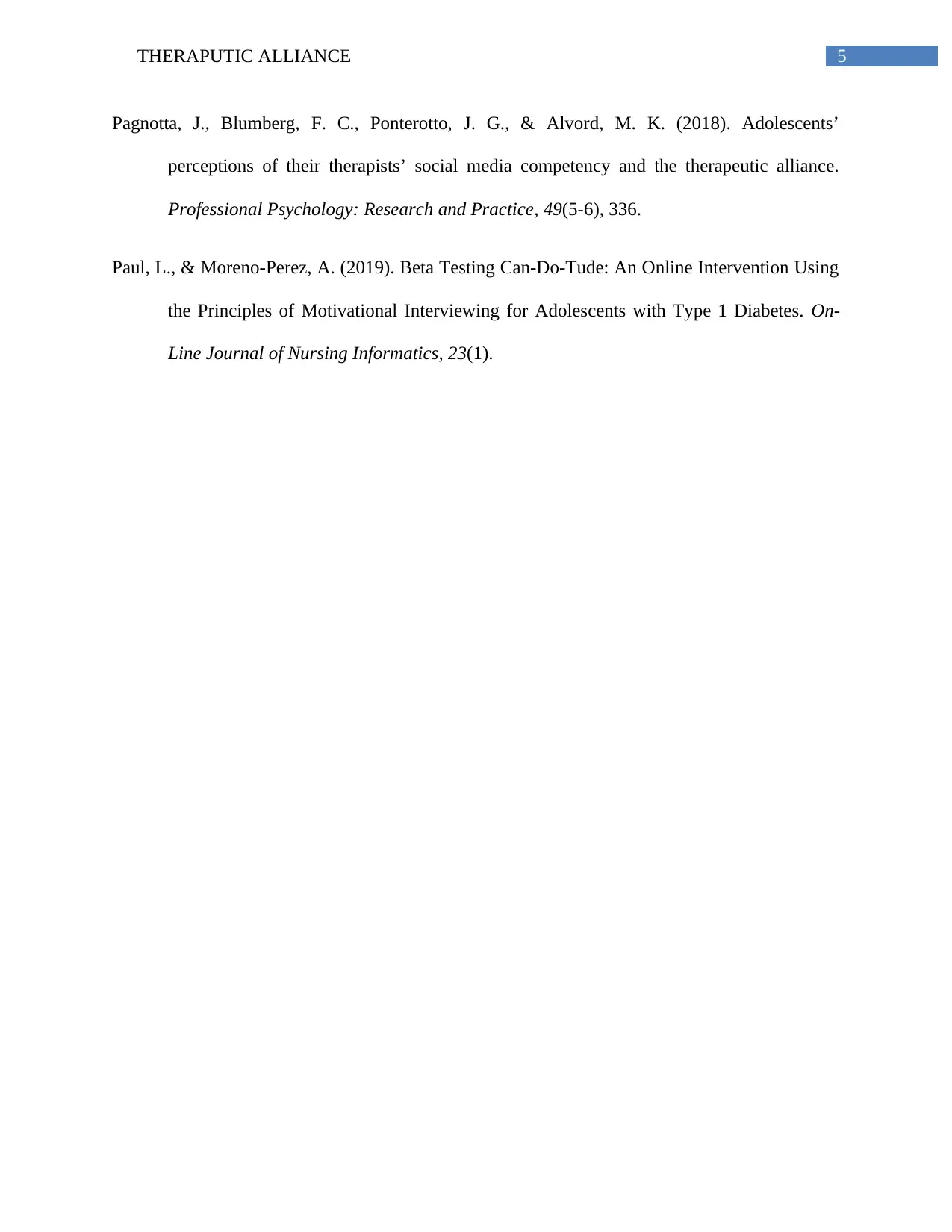
5THERAPUTIC ALLIANCE
Pagnotta, J., Blumberg, F. C., Ponterotto, J. G., & Alvord, M. K. (2018). Adolescents’
perceptions of their therapists’ social media competency and the therapeutic alliance.
Professional Psychology: Research and Practice, 49(5-6), 336.
Paul, L., & Moreno-Perez, A. (2019). Beta Testing Can-Do-Tude: An Online Intervention Using
the Principles of Motivational Interviewing for Adolescents with Type 1 Diabetes. On-
Line Journal of Nursing Informatics, 23(1).
Pagnotta, J., Blumberg, F. C., Ponterotto, J. G., & Alvord, M. K. (2018). Adolescents’
perceptions of their therapists’ social media competency and the therapeutic alliance.
Professional Psychology: Research and Practice, 49(5-6), 336.
Paul, L., & Moreno-Perez, A. (2019). Beta Testing Can-Do-Tude: An Online Intervention Using
the Principles of Motivational Interviewing for Adolescents with Type 1 Diabetes. On-
Line Journal of Nursing Informatics, 23(1).
⊘ This is a preview!⊘
Do you want full access?
Subscribe today to unlock all pages.

Trusted by 1+ million students worldwide
1 out of 6
Related Documents
Your All-in-One AI-Powered Toolkit for Academic Success.
+13062052269
info@desklib.com
Available 24*7 on WhatsApp / Email
![[object Object]](/_next/static/media/star-bottom.7253800d.svg)
Unlock your academic potential
Copyright © 2020–2025 A2Z Services. All Rights Reserved. Developed and managed by ZUCOL.





